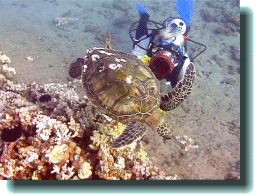
Using the images we've collected, we want to introduce you to the Hawaiian green turtles or "honu" living there.
72K JPEG
"A number of interesting enigmas exist for the Honokowai site... Additional diving surveys need to be undertaken, if and when the number of turtles returns to the levels seen by Heacox in January-February of 1984-1985."
--Balazs et al. (1987)
By means of SCUBA, we have watched, photographed, and videotaped turtles at Honokowai, Maui, Hawaii since 1989. Using the images we've collected, we want to introduce you to the Hawaiian green turtles or "honu" living there, show you what their home is like, and provide some ecological background.

| Using the images we've collected, we want to introduce you to the Hawaiian green turtles or "honu" living there. 72K JPEG |
Appropriately, George Balazs et al. (1987) wrote the first description of Honokowai in sea turtle literature. As they described, with the exception of a small park at the south end, this part of the coast is lined with sea walls built by resort condominiums.
Note that concrete storm sewers mark both ends of our dive site. For years, these discharged runoff from pineapple and sugar cane fields directly into the ocean. Sediment catch basins were not added until 1995. Also, to the south and within 600 m of the shore, a sewage treatment plant pumps over 11 million liters per day of effluent containing high loads of phosphates and nitrates into injection wells (W. Wiltse, pers. comm.).
Although no one has shown a direct connection to these onshore aspects, it is interesting that over the years, West Maui has gotten considerable attention because of repeated seaweed blooms. Studies commissioned in the mid-90's by the West Maui Watershed Management Project (1996, 1997) confirmed that the Honokowai ocean is high in nutrients, and several anthropogenic culprits were implicated, including both of those just mentioned.
Since 1989, Honokowai has had a series of Cladophora sericea algae blooms--five that we've documented, with the worst in 1991. The area is also dominated by two new arrivals--exotic seaweeds. One, Acanthophora spicifera, was reported growing at Honokowai by Balazs et al. (1987) as early as 1985. We have documented that the other import, Hypnea musciformis, had already established itself by 1989. We have also recorded videotape showing young honu feeding on both species.
Since 1989, Honokowai has had a series of Cladophora sericea algae blooms. 27K JPEG | 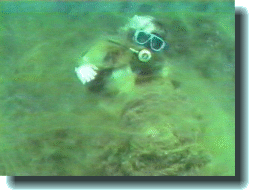
|
Honokowai's environment has also been degraded by run-off events, the most serious in July 1993, when red mud from the West Maui Mountains turned the coastal waters red. In some areas, silt collected in layers 10-15 cm deep.
It is within this setting that we have been observing fibropapilloma disease, or FP. Distressingly, FP has infested Honokowai throughout our observation period, and almost certainly longer than that. 59% (N =268) of the turtles that we have sighted at Honokowai in the last decade had FP. If we count turtles seen in at least two different summers, the rate rises to 74% (N=91). If we stretch residency to four years, the FP prevalence increases to 81% (N =31).
Nearshore Honokowai consists of several well-defined sections of underwater terrain, providing permanent habitat for honu in all size classes.
Inshore, Honokowai is shallow. Seaweeds cover a large part of the bottom and provide forage for juvenile turtles. A number of these algae, A. spicifera and Spyridia filamentosa in particular, have been identified by Landsberg et al. (1999) as being high in okadaic acid-producing dinoflagellates called Prorocentrum. This is of interest because okadaic acid is a known tumor promoter in lab animals.
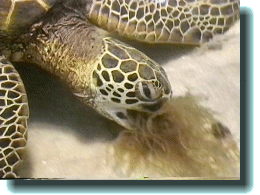
| Seaweeds cover a large part of the bottom and provide forage for juvenile turtles. 45K JPEG |
The Cavern is an example of turtle habitat inshore. Two ledges face each other 5-6 m apart, both capable of accommodating a juvenile turtle. Polzbarney, a 35 cm new arrival in 1995, spent the first year tucked under a coral head, then occupied The Cavern in 1996. In 1999, Polzbarney was still living in The Cavern, had grown to 60 cm, and was in his third year of FP.
At the 10 m depth, a 50 m wide stretch of sand separates the inshore habitat from the beginnings of the reefs, which typically run perpendicular to shore. It is around and on these reefs that we see most of the turtles.
Around Hawaii, sea turtles congregate at areas called "Turtle Houses." In the early 90's Honokowai had just one, which we called the Turtle House. At first, this meant the entire vicinity, but we later evolved names for the distinct sub-areas.
Around Hawaii, sea turtles congregate at areas called "Turtle Houses." 53K JPEG | 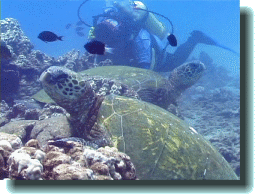
|
The Rock: This feature is called The Rock. Some young honu, such as Hoahele, have used the ledges underneath The Rock for rest and shelter. For most turtles, however, The Rock is simply an outstanding way to satisfy a carapace itch.
The Rest Site: Next to The Rock was a small reef of mixed corals. Turtles often rested there, so we named this the Rest Site. This area has since been reduced to mostly coral rubble--our Destruction poster (Bennett et al., In press a) shows how--and by 1999 we seldom saw turtles resting there.
The Turtle House: Further seaward, across a 25 m sand channel, is the mound of corals that forms the Turtle House proper. Here, we have always observed a considerable amount of cleaning activity. Originally, this area also offered several opportunities for a turtle to scratch, but some have now collapsed.
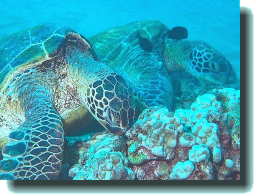
| Here, we have always observed a considerable amount of cleaning activity. 87K JPEG |
Reef 2: In 1995, we began sighting more turtles. Some honu began spending time on a large reef that we called Reef 2. It is at the south end of our dive site, and is primarily a resting site. Reef 2 is made up of mostly finger corals, with narrow channels and depressions that the honu like to settle into. This became the second major congregation area at Honokowai.
There is not much cleaning at Reef 2, but it does have some scratching posts. The most prominent of them is a coral structure we call East House, which has recently collapsed.
North House: In 1998, shore observations revealed shells surfacing to the north for the first time. Therefore, in 1999 we visited the new turtle-congregating area, which we'd already named North House. The most prominent feature in the area turned out to be a large coral head standing alone in the sand. We immediately named this Mt. Balazs.
The most prominent feature in the area turned out to be a large coral head standing alone in the sand. We immediately named this Mt. Balazs. 54K JPEG | 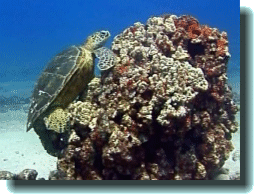
|
A few metres away, a crest of coral rose up 2-3 m. Atop this crest, we saw over a dozen turtles of various sizes, many already known to us. They were doing what turtles do in such a promising area: mostly lying around.
Like the Turtle House, North House is a cleaning station, where turtles pose to attract cleaner fishes. Also like the Turtle House, North House offers opportunities to scratch. Like Reef 2, North House offers numerous resting spots. North House has become the third major Honokowai congregation area.
What do turtles do at Honokowai? Well, the most notable thing they do is stay there. One example is Kaula, known since 1989. Kaula matured into a male during our observation time and still calls Reef 2 home.
Tiamat, known since 1991, is another example of a long-term resident. We sighted her every summer until 1997, when she made her first migration to the French Frigate Shoals. In the summers of 98 and 99, we saw her daily at Honokowai. We expect her to migrate during Summer 2000.
On an average day, we sight over two dozen different honu at Honokowai. On lucky days, a Hawaiian hawksbill shows up. Since 1989, Honokowai has attracted a lot of turtles, with most of the increase happening since 1995. With these honu comes change.
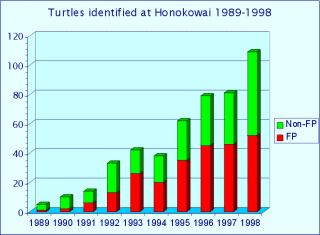
| Since 1989, Honokowai has attracted a lot of turtles, with most of the increase happening since 1995. 46K GIF |
This is the Turtle House in 1989. Note the healthy corals, suggesting that honu were not yet established in large numbers.
Certainly our pictures show that the coral destruction at Honokowai is recent, occurring in the last decade. This is the same area just three years later. Note the coral head has been fractured.
Finally, here it is in 1999. Clearly, honu are hard on corals.
Although honu destroy a lot of coral through scratching and foraging, most damage results from the simple act of resting. Honu, year after year, are faithful not just to the same reef, as we show in our poster on Fixity (Bennett et al., In press b), but also to the same precise resting spots.
This inevitably means the demise of corals. Finger corals snap easily and litter individual rest sites. Such sites are easy to spot even without a turtle present. We call these Turtle Tramples for obvious reasons.
Finger corals snap easily and litter individual rest sites. Such sites are easy to spot even without a turtle present. 66K JPEG | 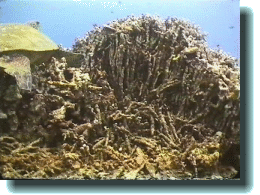
|
How do honu affect other marine inhabitants?
It's likely that the most significant effect involves fish cleaning activity. We've always observed shell cleaners like goldring surgeonfish (Ctenochaetus strigosus) and skin pickers like Hawaiian spotted pufferfish (Canthigaster jactator) working on turtles. Saddleback wrasses (Thalossoma duperrey) target only tumored turtles, something we've noted since 1990.
We've also documented species that have learned cleaning behaviour. For example, between 1994 and 1995 both milletseed butterflies (Chaetodon miliaris) and long-nosed butterflies (Forcipiger flavissimus) took up cleaning tumored turtles. In 1999, for the first time we observed yellow tangs (Zebrasoma flavescens) cleaning turtles.
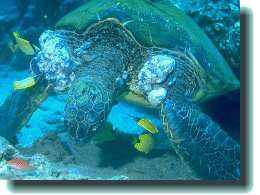
| Between 1994 and 1995 both milletseed butterflies and long-nosed butterflies took up cleaning tumored turtles. 77K JPEG |
Fish also use honu for shelter, as cover from which to surprise prey, and will show up when a turtle is actively scratching or foraging for sponges. By disturbing the corals, the turtle is unintentionally making food accessible. The incidental destruction of corals also has a detrimental effect on reef fish and other animals, however, since habitat is being lost.
Certainly one of the most fascinating events at Honokowai in the last decade was the 1998 appearance of a young hawksbill (Eretmochelys imbricata). We sighted Keoki again in 1999 and also that year, we began seeing another larger hawksbill--Ake.
This is remarkable because Hawaiian hawksbills are extremely rare and Honokowai managed to attract two! We now believe it is possible, perhaps even likely, that the presence of honu are an attraction for hawksbills--an advantage.
Every day, the honu change the nature of the reefs of Honokowai. This uprooting and trampling of corals gives the hawksbills access to previously unreachable sponges.
Still, hawksbills can write their own meal ticket. They dig distinctive holes anywhere they sense sponges might be hidden--leaving some coral fingers snapped cleanly in two! These holes are the hawksbill's "calling cards" along Honokowai's reefs.
Hawksbills can write their own meal ticket. They dig distinctive holes anywhere they sense sponges might be hidden--leaving some coral fingers snapped cleanly in two! 45K JPEG | 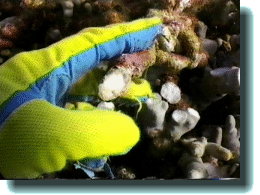
|
Observations confirm that the hawksbills are cleaned by many of the same fish species as the honu, share honu resting sites, and sometimes even eat the same type of seaweed, H. musciformis, as shown here. On rare occasions, they even rest next to honu. There seems little doubt they're exposed to the same FP environ. Needless to say, we're monitoring these hawksbills closely.
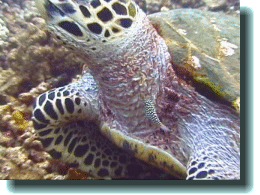
| Observations confirm that the hawksbills are cleaned by many of the same fish species as the honu. 58K JPEG |
To summarize, we know that turtles of all size classes have settled at Honokowai and stayed for years, some at least a decade, despite high nutrient loads and sporadic runoff events.
Since 1989, Honokowai has seen an encouraging increase in the number of turtles. During our observation time, these animals have spread out, occupying two new congregation areas. Judging by the effects we have seen them have on the corals, recovery and colonization have been recent--in the last decade--and in spite of a high prevalence of fibropapilloma.
We believe there's a strong possibility that if a youngster settling into Honokowai survives FP, it will mature there, migrate to the French Frigate Shoals and back during its reproductive years, age, and ultimately die at Honokowai. We're confident that one day the remarkable bond of the honu to their underwater home will be recorded in decades, not just years.
We're confident that one day the remarkable bond of the honu to their underwater home will be recorded in decades, not just years. 74K JPEG | 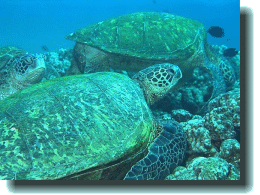
|
The Honokowai honu are a true "ohana"--Hawaiian for a group that has shared experience--with individuals that live together and interact over decades. Given the number of years that sea turtles live at the same site, it is therefore important to remember to keep the ocean clean!
The authors wish to express their thanks to George H. Balazs for his encouragement and support over the years, and particularly for the perfect word "ohana". In addition, the first author acknowledges her indebtedness to George for his mentorship, his patience and--most of all--for his time.
Bennett, P. A., U. Keuper-Bennett, and G. H. Balazs. In press a. Changing the landscape: evidence for detrimental impacts to coral reefs by Hawaiian marine turtles. In Proceedings of the Twentieth Annual Symposium on Sea Turtle Biology and Conservation, February 29-March 4, 2000, Orlando, Florida. U.S. Dep. Commer. NOAA Tech. Memo. NMFS-SEFSC.
Bennett, P. A., U. Keuper-Bennett, and G. H. Balazs. In press b. Remigration and residency of Hawaiian green turtles in coastal waters of Honokowai, West Maui, Hawaii. In Proceedings of the Twentieth Annual Symposium on Sea Turtle Biology and Conservation, February 29-March 4, 2000, Orlando, Florida. U.S. Dep. Commer. NOAA Tech. Memo. NMFS-SEFSC.
West Maui Watershed Management Project. 1997. West Maui Watershed Owner's Manual. 104 p.
 Who's Who Underwater at Honokowai
Who's Who Underwater at Honokowai